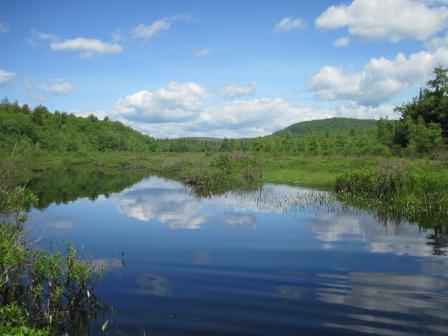Maine's Comprehensive Wetland Program is Built Upon Monitoring & Assessment
Maine’s abundant wetland resources provide its residents and visitors with a wide variety of outdoor recreation opportunities and serve vital functions related to water quality, flood control, and shoreline protection. Wetlands also provide habitat for a diverse array of wildlife and aquatic life. In an effort to improve methods to assess wetland health, the Maine Department of Environmental Protection (DEP) Biological Monitoring Program Exitkick started its wetland monitoring initiative with a pilot project back in 1998. Today, the program successfully assesses the condition of freshwater wetlands statewide by evaluating macroinvertebrate and algal communities to comply with Maine’s water quality standards. Results are used to support wetland regulatory and management decisions to ensure long term protection and improvement of Maine’s aquatic resources for future generations.
River and stream biomonitoring data have been used in Maine since the 1980s to inform a variety of resource management activities and regulatory programs. These decisions are supported by biological criteria based on sound statistical modeling. In recent years, requests to the Biological Monitoring Program for assessments of wetland water quality and condition have increased. In response, and with the financial assistance of Wetland Program Development Grants (WPDG), DEP biologists developed a linear discriminant model (LDM) using aquatic macroinvertebrate community data to help determine if monitored wetlands are attaining narrative biological criteria. Macroinvertebrates are animals without backbones that can be seen without the aid of magnification, such as a crayfish, snails, and a variety of insects. Sites included in the LDM were wetlands containing emergent and/or submerged plants, such as marshes, shallow lakes and ponds and low gradient streams. DEP recently completed a similar model for wetland algal species, and has developed taxa tolerance values and community level tolerance indices for macroinvertebrates and algae.
The Biological Monitoring Program coordinates sampling of rivers, streams and wetlands using a 5-year rotating basin schedule. Collecting biological data for different water body types and habitats within the same river basin during a given year allows DEP biologists to evaluate aquatic resource condition on a watershed scale. Teaming up with DEP’s other water quality programs has been instrumental in building capacity for wetland assessment through sharing technical expertise, staff and other resources. The use of WPDG’s has been essential to the wetlands component of the Biological Monitoring Program. WPDG dollars have been the major funding source beginning with the 1998 pilot project and for all subsequent wetland monitoring and assessment projects. The program currently monitors primarily open-water wetlands, but DEP recently conducted a study of red maple swamps and is exploring the use of biological indicators based on wetland plants. Continued support from WPDG funds will enable the Biomonitoring team to assess additional types of wetlands in the future.
Maine DEP has set a precedent for transparency of monitoring and assessment results by utilizing Google Earth to provide the public with sampling locations, data reports and images.ExitBiological Monitoring Program staff also participated in the last two rounds of EPA’s National Wetland Condition Assessment (NWCA) in 2011 and 2016.

